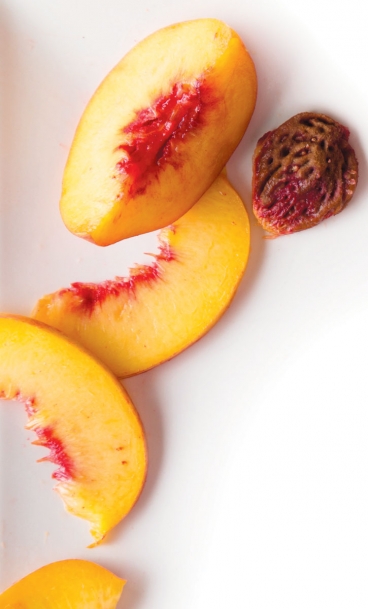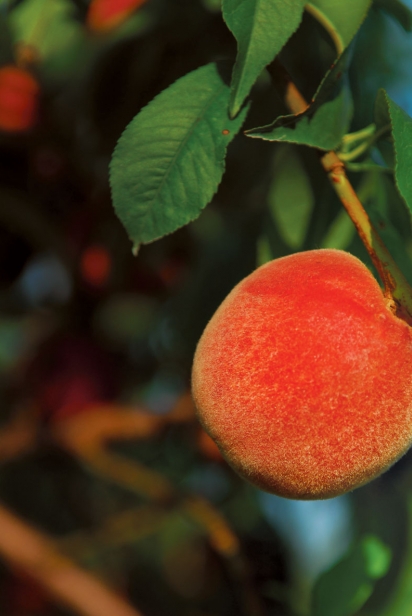The Edible Garden: Growing Fruit Trees
If it is true that growing garden herbs is like “growing edibles with training wheels,” as respected gardening expert Rosalind Creasy suggests, then growing fruits is more like motorcycle stunt riding: It takes a bit more practice and an adventurous gardening spirit. Yet the beauty of fruit trees is unmatched and, when added to the edible garden, they combine gardening style with delicious function. One bite of a homegrown peach, apple or other fruit makes the effort more than worthwhile. Moreover, the extensive use of fruit for recipes including entrees, desserts and canning make this an edible gardening adventure worth taking.
For this article, I’ll focus on a favorite fruit tree—the peach.
Every fruit tree has its own nuances and varieties so knowing local resources that can assist you is essential. Knowledgeable garden center staff and your local agriculture extension office are two important guides that can assist you in choosing and planting your personal orchard.
Beginning with a good, strong specimen is the first step towards success. Though it is possible to grow a tree from a peach pit, the process will take much longer and the resulting tree and its fruit will not always be satisfactory. Choose a five-gallon container size tree and look for a straight and blemish-free stalk and a healthy root structure. To inspect roots, gently tug on the tree near its base and carefully remove the sapling a few inches to see the roots below the surface of the container. Roots should be numerous though not too entwined or root-bound.
Peaches are classified in three groups: freestone, clingstone and semi-freestone. This refers to the way the fruit clings to the seed or pit. The most common peaches in many grocery stores are clingstone because this variety can be transported without excessive bruising. For superior cooking and baking, freestone peaches are an excellent choice, which is why Elberta peach trees are often found in a cook’s garden. They also make a good choice for an Oklahoma garden because they do well in our zone (zone 6). Even though Elberta is a self-pollinating variety (which means that one tree can produce fruit without another fruit tree near), more production will be obtained when you plant at least two in a sunny, open spot in your edible garden.
As with most trees, fall is the best time for planting because the ground is warm from the summer while the temperature is cooling for fall. Also, pests are less active as they prepare for dormancy for cooler months. Find an open space free from overhanging branches of other trees or electrical wires. The Elberta peach tree variety will grow to 25 feet tall and its spread can be every bit of that, too. Consider neighboring structures such as sheds or homes to insure that unnecessary pruning has to be done as the tree grows to maturity.
In general, most trees will do best in well-drained soil, which means that the existing soil in most gardens will need to be amended if not removed and replaced. Don’t skip the important step of digging the appropriate size hole for the tree (twice the size of its container) and adding sandy, nutritional loam. Soils specifically designed for trees and shrubs are best because they have a soil structure that allows for moisture to nurture the roots while keeping soil from becoming soggy.
Fruit trees are particularly prone to disease and pests. For the peach, one nemesis is the Oriental Fruit Moth, which pierces the small fruit and lays its eggs. You’ll notice sap spilling from the fruit and, if not caught in time, this invasive pest will destroy your crop. To treat, look for “BT” (Bacillus thuringiensis), a natural, nonpathogenic bacterium that is found naturally in the soil. “BT” has been found to be safe to all animals and is readily found at local garden centers and agriculture centers.
Employ nature’s most effective pest control: companion planting. Peach trees benefit from being near garlic, marigolds and basil. A yellow flowering herb called Tansy planted at the base of peach trees will help repel borers and flying insects. Avoiding planting your peach orchard near tomatoes, potatoes or raspberry bushes as these encourage blight.
Like most shrubs and trees, fruit trees require year-round maintenance. While the tree should produce some fruit in its first two or three years, the fruit will be larger and more stunning after three years of care. Learning the importance of pruning and how to stake a tree to protect against Oklahoma winds are key. And, like all life in the garden, feeding with an organic food in the spring and fall will improve the health and beauty of your growing orchard.







